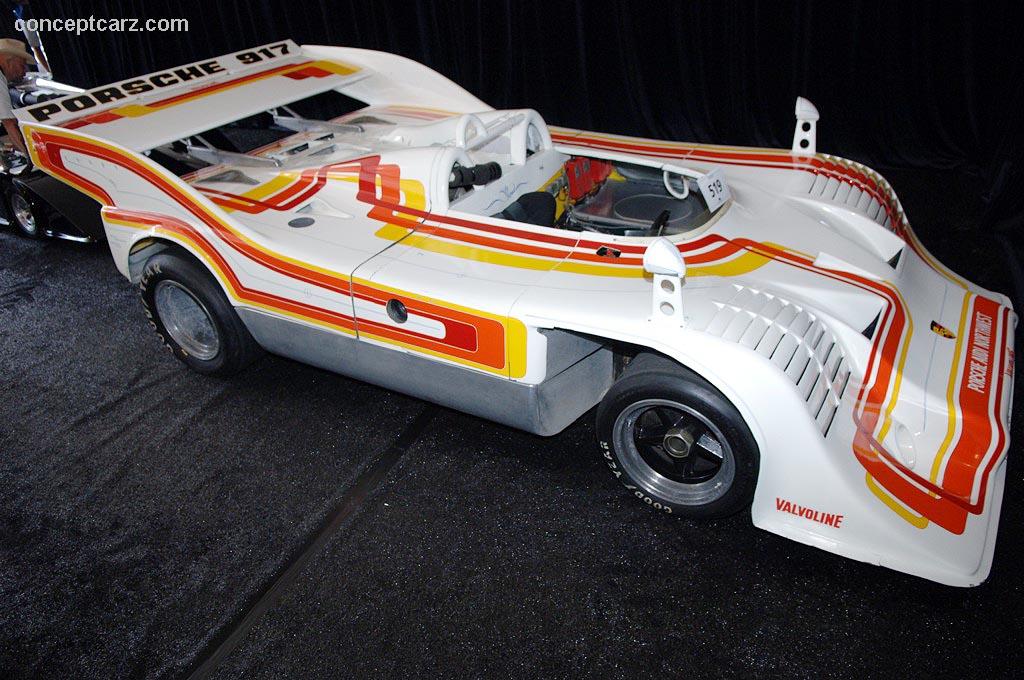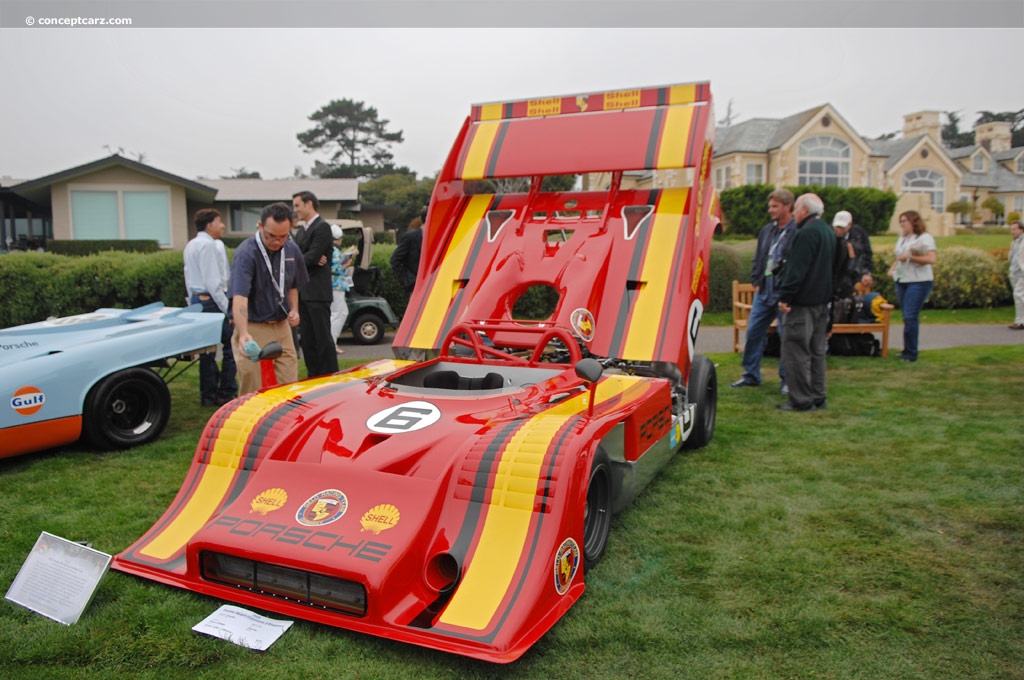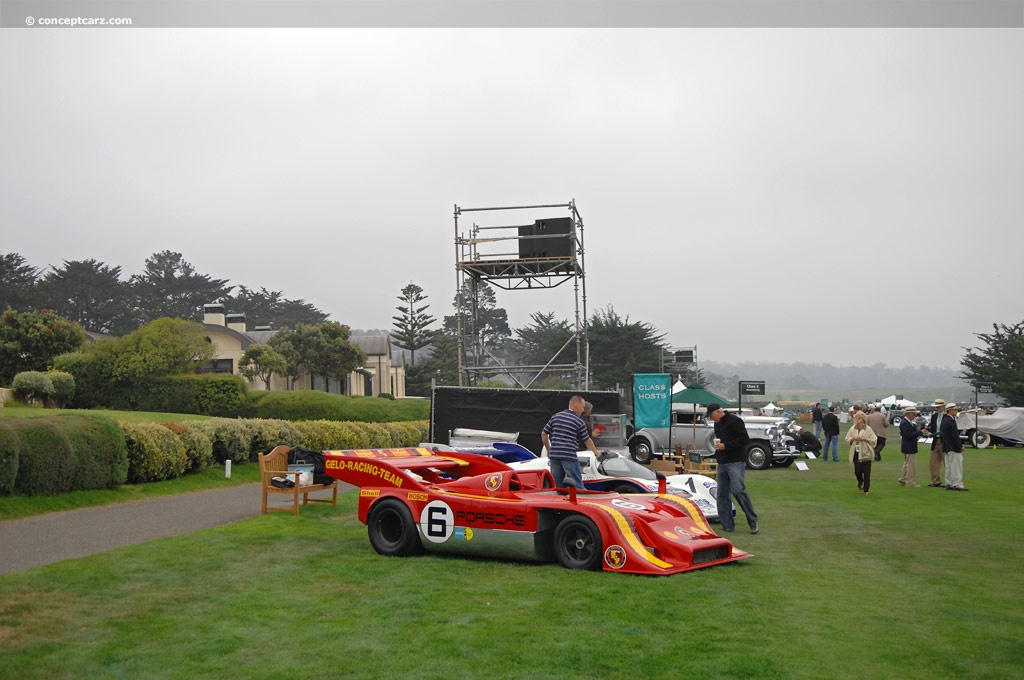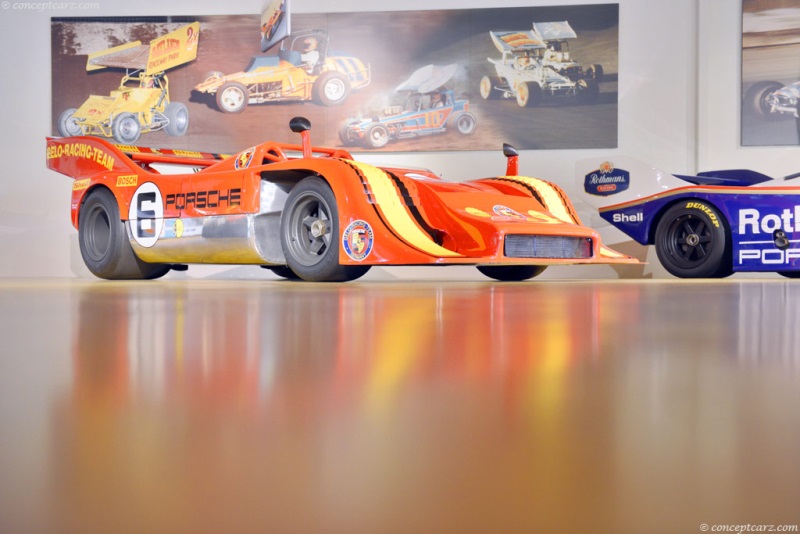Since the mid-1960s, the Porsche racing department, under the leadership of Ferdinand Piech, had created a new prototype racer nearly every year. With the introduction of the 904 model in 1964, a competition-designed sports GT, Porsche began a tradition of extolling the virtues of their production cars by building competition cars with street engine configuration. It was followed by the Porsche 906, known as the Carrera 6, which would be the last street-legal race car from Porsche. The three-liter, eight-cylinder engined 908 won the World Championship in 1969 but Porsche wondered if it would be powerful enough to take the overall victory away from the Lola T70s and Ford GT40s at LeMans. 
Racing Spyder
Chassis #: 917/10-015
View info and history
Auction entries : 1When the FIA dropped the production requirement for Group 4 five-liter sports cars from 50 to 25 for 1969, the Porsche factory saw its opportunity, and the 917 was born. It used the tubular frame of the 908 but was constructed from lightweight aluminum instead of steel, which reduced both weight and rigidity. It received a fully independent suspension, comprised of wishbones, and powered by a twelve-cylinder engine displacing 4.5 liters. The engine used a new camshaft and crankshaft design which allowed it to be much shorter than the prior 908 engine. Although shorter, it was still large, requiring a slightly wider body than the 908 and moving the cockpit forward. Porsche unveiled its aluminum-tube framed 917 in March of 1969 at the Geneva Auto Show. By May 1, with 25 examples built, the FIA homologated the 917 as a Group 4 sports car.Despite its power output and many race-proven components, the 917 was not an immediate success. Many factory drivers preferred the less powerful 908 with its predictable handling. At the 1969 Le Mans practice session, factory drivers reported that the car was very unstable at its over 200 mph top speed, in spite of which it nearly won the race on its first appearance. The 917 short-tail coupe's first victory was in August of 1969, at Zeltweg, Austria. At the end of the season, John Wyer's JW racing team took over the running of the 917 from the factory and quickly modified the rear bodywork to resemble that of the Lola T70 coupe, resolving the handling issues and increasing its performance. In Wyer's Gulf Oil-sponsored team's hands, the 917 won the World Championship both in 1970 and 1971, before being outlawed in favor of three-liter cars once more. Porsche's first overall Le Mans victory was from a 917K entered by the Porsche-Salzburg team.
Racing Spyder
Chassis #: 917/10-017
View info and historyThe Porsche 917s won 15 of the 24 World Championship races they entered over a two-year period, 11 of them by the Gulf-Wyer cars. They would win more races in the Can-Am, Interserie, and Manufacturers World Championship than any other two-seater racecar ever produced. They claimed victory at the Sebring 24 HOurs, Daytona 12 Hours, Le Mans 24 Hours, 1000 Kilometres at Monza, Spa, and the Nürburgring. After the 1971 season, the 917 became ineligible to race in the world championship, so Porsche turned its attention to the nearly no-limit Group 7 class of the European Interserie and the North American SCCA Can-Am Challenge (Can-Am). The 917 had been competing in Group 7 since 1969, but with little factory support. Privateers raced the 908 or open-top versions of the 917. Can-Am was important to Porsche because, at the time, about half of their car production was sold in the United States.In 1971 Porsche introduced a Group 7 version of the 917 named the 917/10. For five seasons the North American series of 200-mile sprint races had been dominated by Team McLaren and Porsche hoped that with the 917/10, the balance of power would shift their way. Introduced part-way through the 1971 season, it scored several points during its inaugural season, yet it was quickly evident that the 5-liter flat 12 was not powerful enough to contest the all-alloy Chevrolet V8s. A solution was found with the addition of twin-turbochargers which brought horsepower into the neighborhood of 1000 bhp. 
Racing Spyder
Chassis #: 917/10-017
View info and historyMark Donohue and George Follmer raced the 917/10 during the 1972 season, although Donohue's season was cut short following an injury during a testing accident at Mosport. Follmer's first race in the team Roger Penske 917/10 was at Road Atlanta, which he won - the first of five victories. He twice lapped the entire field. Donohue was healed by the end of the 1972 season which gave Team Penske a two-car 917/10 Can-Am team again. The following season was won by Donohue in the even more powerful Team Penske 917/30 while Follmer driving for new owner Bobby Rinzler finished second in the 917/10. For the 1974 season, the SCCA introduced a 3 miles per U.S. gallon maximum fuel consumption rule in response to the oil crisis of the era. Thus, the Penske 917/30 completed in one race in 1974 and several customers modified their 917/10K with naturally aspirated engines. A total of 13 examples of the 917/10 were built and they were the only championship-winning car in Can-Am to not be powered by Chevrolet.
by Daniel Vaughan | Apr 2020

Racing Spyder
Chassis #: 917/10-015
View info and history
Auction entries : 1

Racing Spyder
Chassis #: 917/10-017
View info and history

Racing Spyder
Chassis #: 917/10-017
View info and history
by Daniel Vaughan | Apr 2020
1972 Porsche 917/10 Vehicle Profiles
Recent Vehicle Additions
Related Automotive News

Popular Trans-Am Categories Geared Up For Spring Classic May 19-21
MONTEREY, Calif., March 1, 2017 — The Spring Classic vintage car race and historic motorcycle exhibition to be held on May 19-21 features 10 run groups with racers from around the country excited to take part in the inaugural event during Mazda...
All-Star Cast of Cars, Drivers at Porsche Rennsport Reunion V
The Porsche highlights for a weekend full of highlights
Atlanta, Georgia. For the Porsche Rennsport Reunion V taking place at Mazda Raceway Laguna Seca this weekend, both the men and the machines they drove are expected to outdraw one...

VIC ELFORD RECEIVES RRDC'S 2015 PHIL HILL AWARD
DAYTONA BEACH, Fla. (Jan. 22, 2015) - Vic Elford, considered one of the fastest race-car drivers of the Sixties and Seventies, was honored by the Road Racing Drivers Club with the 2015 Phil Hill Award. RRDC president Bobby Rahal made the presentation...

HURLEY HAYWOOD HONORED WITH RRDC'S 2014 PHIL HILL AWARD
DAYTONA BEACH, Fla. (Jan. 24, 2014) - Hurley Haywood, winner of more endurance classics than any other driver in racing history, was honored by the Road Racing Drivers Club with the 2014 Phil Hill Award. RRDC president Bobby Rahal presented Haywood...

1967 Can-Am Road America: The Beginning of the 'Bruce and Denny Show'
While Formula One will be forever considered the pinnacle of motorsport, from a period between 1966 and 1986 there existed a series that would likely be the closest to anything goes as any motor racing series could truly get. Based upon the FIA Group...







































